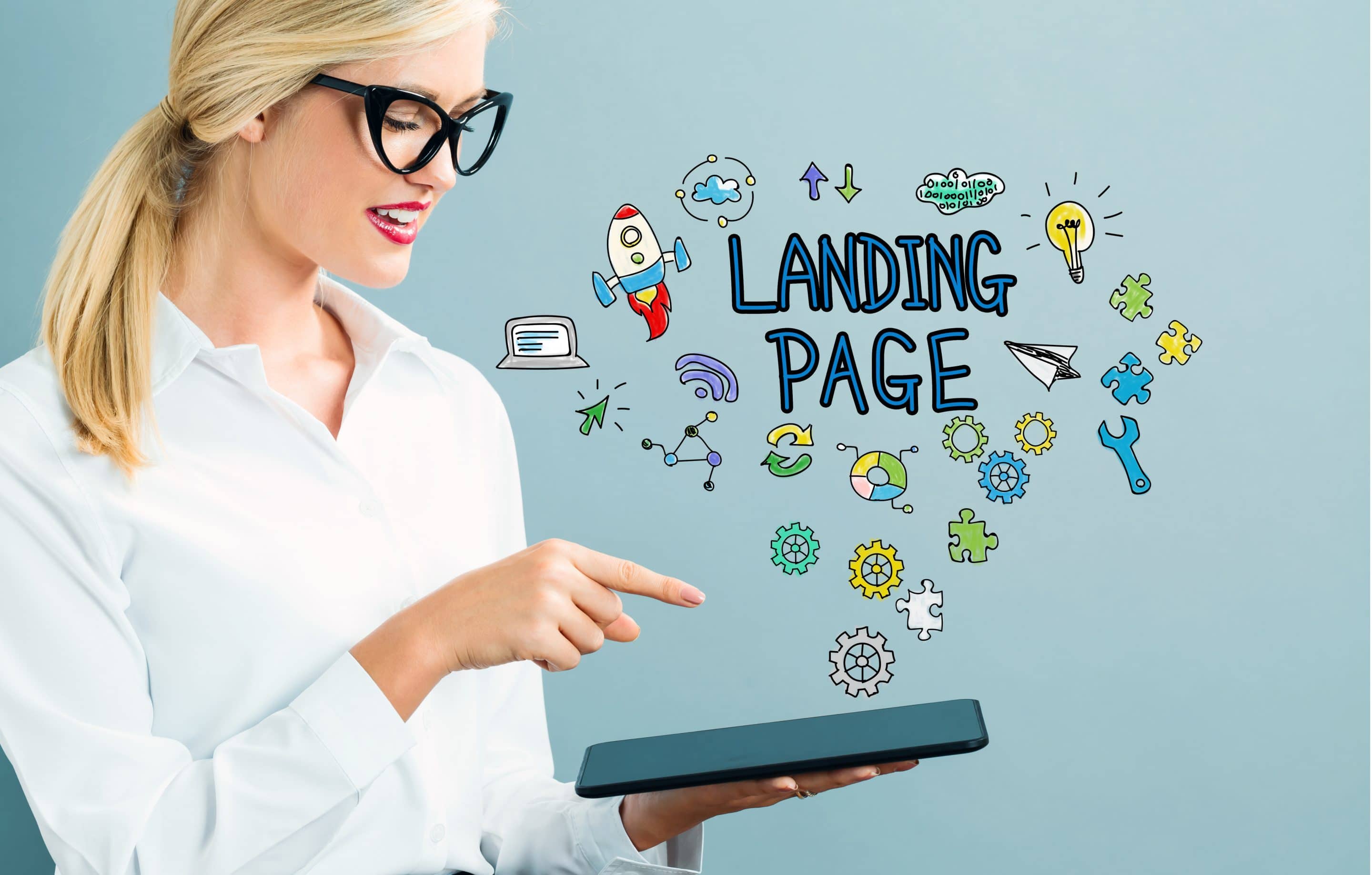When it comes to digital marketing, you may be running the most amazing social media ads in the world, but what happens when users click on the link? Where do they go? Whatever link you specify for them to land on is called the “landing page,” and if it’s not effective, your digital marketing strategy is bound to fail.
Why You Need Landing Pages In Your Digital Marketing Strategy
Landing pages are often used in digital marketing advertising campaigns like those run on social media sites like Facebook or Pinterest, although any page visitors “land” on first is a landing page. For a successful digital marketing strategy, it’s important you recognize each and every landing page as an opportunity to capture a potential client’s interest.
What’s the point of your landing page? Copyblogger shares five purposes yours can have:
- Get a visitor to click to go to another page
- Get a visitor to buy
- Get a visitor to give permission for you to follow up by email, phone, etc.
- Get a visitor to tell a friend
- Get a visitor to comment or give you some sort of feedback
As you can see, the whole point is to drive visitors to take action.
How to Create Landing Pages That Will Drive a Successful Digital Marketing Strategy
A successful landing page, like this one, includes 10 elements for digital marketing success.
The Focus Remains on the Visitor

Just as your target audience needs to be the focus of your digital marketing strategy, your visitor needs to remain the focus of your landing page. Everything on the page needs to be created with the goal of resonating with them.
As MailMunch explains, “It’s very easy (and common) to sit down and write copy for a landing page without ever really thinking about the customer. The copy is all about them. The features, practical outcomes, and tangible elements of the offer. Your copy needs to help prospects understand why they should care.”
A Single Call to Action / Digital Marketing Goal
What’s your digital marketing goal? When visitors come to your landing page, what you do you want them to do? That’s your call to action. Communicate it clearly throughout the page.
It may seem counterintuitive – after all, many people like options – but by taking away potential distractions they’ll easily move onto the next step you’d like them to take.
In fact, one study found that removing a navigation menu altogether increased conversions by 100 percent! Research also shows that landing pages with multiple offers get 266 percent fewer leads than those with a single offer.
Also think about a potential offer you can extend to visitors. For example, if you’re asking visitors to join your email list, maybe you can offer some sort of helpful industry research or guide to provide incentive. Another offer could be a discount on your products or services, or entry into a giveaway. Regardless of what you choose, keep your customer front of mind and make sure it ties seamlessly into your call to action.
It’s also important to place your call to action strategically. It needs to be at the top of the page, visible without the visitor needing to scroll. Depending on the page’s length, repeat your call to action so consumers are reminded of it as they scroll down.
Consistent Branding

Consistent branding will ensure your landing page fits in naturally with the rest of your digital marketing strategy.
Your landing page needs to fit within your overall branding theme through similar fonts, colors, language and visuals; it should be a natural extension of your other digital marketing elements.
Your landing page should also be a natural next step in your digital marketing strategy. If they click on a social media ad, banner ad or email newsletter link and end up on your landing page, it should be a seamless fit with the prompt they saw.
As WordStream explains, “If a user clicks an ad about sleeping bags, don’t drop them in the camping section – you want to bring them to their exact desired destination. Match the user’s need as closely as possible – that’s where the conversions happen!”
Short and Sweet Text
Your landing page’s text should be concise, with a low word count, strategic formatting, compelling headlines and simple, specific language.
As this infographic explains, you have about 5 seconds to capture a visitor’s attention. Make it count by using bullet points, numbered lists and bold (selectively and strategically). Your copy should highlight just the most important points of your product or service.
This infographic also shows the correlation between the number of words on a page versus the conversion rate. For example, those in the service sector with fewer than 100 words convert 50 percent better than those with more than 500 words.
As you review your landing page copy, consider these digital marketing tactics:
- Speak to the heart first, then the head. MailMunch explains, “As consumers, we make decisions with our hearts and justify those decisions with practical data and functionality.” You can use headlines to capture attention that speaks to visitors’ emotional desires, then use the text that follows it to provide practical, articulate backup of your initial point.
- Tie features and benefits together. You can lay out all the features in the world, but if you don’t explain how they benefit the consumer they’re pointless. MailMuch puts it another way: “Features by themselves may appear dull or boring, but when they are tied to benefits, they become compelling and interesting.”
Engaging Visuals

You can have the most amazing digital marketing text in the world, but without compelling, engaging visuals, consumers are going to see a wall of text and move on. Images and videos can break up the text and capture visitors’ interest more effectively. MailMunch suggests:
- GIFS to illustrate the offer
- Text formatting such as bold text, italics, headers and different color fonts
- Images of people, products or abstract scenery
You may also want to consider using videos. Research shows having them on landing pages increases conversions by 86 percent.
Neil Patel also explains elements of a tidy visual digital marketing design, considering the look of the page as a whole.
- A clean, simple design with plenty of white space keeps people trained on your call to action.
- Big font makes it easy and compelling for them to read and understand what your site is all about.
- Bullets make big blocks of copy easy to scan.
- Videos pack a big impact into a small space and can increase conversions.
- Images and graphics that are relevant to your product and related to your audience support your message instead of diverting attention.
Remember that less is more. Choose your images and videos carefully.
Strategic Formatting
There’s more formatting strategy than the headlines, bullet points and bold as recommended above. Research shows the eye naturally looks in an F or Z pattern. Take this into account as you decide where to put which information on your landing page.
A lot of successful landing pages also include form fields for visitors to fill out. Keep these short, only requiring the necessary information; studies show that decreasing the number of fields from 11 to 4 increased conversions by 120 percent.
Established Credibility

How can you show visitors they can trust you? Neil Patel explains, “As social creatures, humans tend to place greater value on things that other people have already approved. That is why most sites will tend to display evidence of such social validation.”
This digital marketing concept is also known as “social proof.” The idea is that a third party reinforces your main points, proving that you’re trustworthy. Research from Nielsen backs this up, showing that 83 percent of consumers trust recommendations from their peers over advertising.
While not every landing page visitor will have friends that can endorse you, you can provide social proof by including:
- A list of your customers
- Testimonials from clients
- Press mentions
- Usage statistics
- Case studies
- Reviews and ratings
Mobile-Friendly Design
Studies show consumers are spending more time browsing on their phones rather than their computers. In just one year alone, from 2016 to 2017, the number of website visits from mobile devices grew from 57 percent to 63 percent, and the percentage of website time spent on mobile devices from 40 percent to 49 percent.
For digital marketing success, you need to make sure your landing pages are visually appealing, easy to navigate and responsive on users’ mobile devices. Before promoting your page, make sure you and your team test them on your own phones and tablets, ideally with as wide a variety of browsers and operating systems as possible.
Quick Page Load Speed

How long does it take for your landing page to load? Studies show 40 percent of consumers abandon a website that takes more than 3 seconds to load, and if an e-commerce website is making $100,000 a day, a 1-second page delay could cost them $2.5 million in lost sales every year!
You can reduce your page load time by removing unnecessary text and graphics. When you test the page on different mobile devices (as well as your desktop), pay attention to how long it takes to load.
Split Testing
The last, but certainly not least important digital marketing guideline, is to split test, or A/B test, your landing page! How do you know if it’s effective if you don’t test it?
Make a few different versions of the page and then run them against each other. Watch the results to see which performs better, then test another element. Test as much as possible – page layout, wording, images, etc. – so you can end up with the most effective landing pages for your digital marketing strategy.
Need Help Creating Landing Pages For Your Digital Marketing Strategy?
We’d love to help you create and test landing pages that will seamlessly integrate into your digital marketing strategy! Contact us today for a complimentary consultation and we can discuss specifics of how we can help.
Special Offer:
Sign up for a complimentary consultation during December and receive an Annual Marketing Planning Guide valued at $475! We offer a 30-minute phone consultation with our CEO, and can answer your questions and discuss your specific marketing needs - no strings attached. Call 408-218-2391 or contact us today to arrange your consultation!

